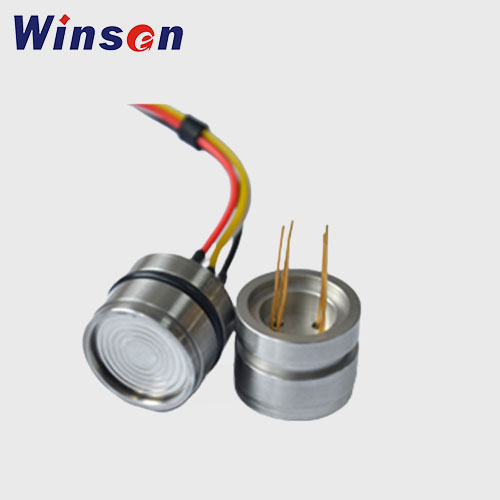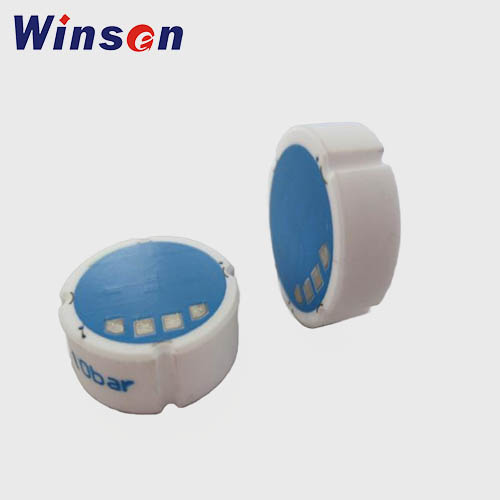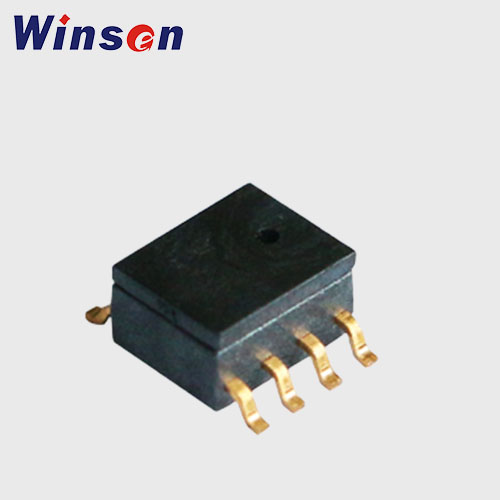WPAK63 Diffused silicon pressure sensor
- Φ19mm standard OEM pressure core
- Can be customized according to special needs
- Provide the solution
A pressure sensor is a sensor that converts pressure signal into an electrical signal output.
While talking about pressure sensors, we must derive the concept of pressure transmitters.
Usually the pressure sensor consists of two parts, namely the sensitive element and the conversion element. The sensitive element refers to the part that can directly sense or respond to the measured; the conversion element refers to the part that converts the measured strain sensed or responded by the sensitive element into an electrical signal suitable for transmission or measurement.
Since the output signal of the sensor is generally very weak, it needs to be amplified. With the development of integration technology, people also install this part of the circuit and power supply inside the sensor together. In this way, the sensor can output usable signals for easy processing and transmission.
A pressure sensor generally refers to a sensitive element that converts a changing pressure signal into a corresponding changing resistance signal or capacitance signal, such as: piezoresistive elements, piezocapacitive elements, etc. The pressure transmitter generally refers to a complete set of circuit units for measuring pressure composed of pressure sensitive elements and conditioning circuits. Generally, it can directly output standard voltage signals or current signals that are linearly related to pressure for instruments, PLCs, acquisition cards, etc. collected directly from the device.
There are many types of pressure sensors, such as resistance strain gauge pressure sensors, semiconductor strain gauge pressure sensors, piezoresistive pressure sensors, inductive pressure sensors, capacitive pressure sensors, resonant pressure sensors, etc. Can be divided according to different work principles, chip types and pressure types.
A.Different work principles: resistive, capacitive, inductive, semiconductor, etc.
B.Different sensor chips: ceramic, diffused silicon, monocrystalline silicon, sapphire, etc.
C.Different pressure target: differential pressure, gauge pressure, absolute pressure, sealed gauge pressure, etc.
Currently widely used pressure sensors include: diffused silicon piezoresistive pressure sensors, ceramic piezoresistive pressure sensors, sputtered film pressure sensors, capacitive pressure sensors, and sapphire pressure sensors with high temperature resistance. But the most widely used is the piezoresistive pressure sensor, which has extremely low price, high precision and good linearity.
Pressure sensors have naturally become the most commonly used sensors various industrial control environments, involving water conservancy and hydropower, railway transportation, intelligent buildings, production automatic control, aerospace, military industry, petrochemical, oil wells, electric power, ships, machine tools, pipelines and many other industries.
The pressure sensor can directly convert the measured pressure into various forms of electrical signals, which is convenient to meet the requirements of centralized detection and control of the automation system. so it is widely used in industrial production, and extensively in many monitoring and control applications. In terms of performance, price, safety, small size and convenience of actual operation, it has been proved that the effect of choosing a pressure sensor is very good. To a certain extent, it can improve the accuracy of system testing.
The pressure sensor is mainly used in the hydraulic system to complete the closed-loop control of the force. When the control spool moves suddenly, a peak pressure several times the system working pressure will be formed in a very short time. In typical mobile and industrial hydraulics, any pressure sensor would quickly be destroyed if it was not designed for such extreme conditions. It is necessary to use an anti-shock pressure sensor. There are two main methods for the pressure sensor to achieve anti-shock, one is to change the strain gauge chip, and the other is to connect an external coil. Generally, the first method is used in the hydraulic system, mainly because Easy to install. Another reason is that the pressure sensor is subjected to constant pressure pulsations from the hydraulic pump.
In addition to direct pressure measurement, pressure sensors can also be used to indirectly measure other quantities, such as liquid level/gas flow, velocity, water level. There is also a type of pressure sensors designed to dynamically measure high-speed changing pressure. Example applications are combustion pressure in engine cylinders or pressure monitoring of gases in turbine engines. Such sensors are generally manufactured from piezoelectric materials, such as quartz.
Pressure sensors play an important role in injection molds. The pressure sensor can be installed in the nozzle of the injection molding machine, the hot runner system, the cold runner system and the cavity of the mold. It can measure the flow of plastic from the nozzle of the injection molding machine to the Plastic pressure somewhere between cavities.
Based on the special environment of mine, pressure sensors for the mining use mainly include: semiconductor piezoresistive pressure sensors, metal strain gauge pressure sensors, differential transformer pressure sensors, etc. These sensors are widely used in the mining industry.
Pressure sensors are often used in air compressors, and air-conditioning, refrigeration equipment, and heat pump. These sensors are small in size and easy to install.
Winsen has more than 20 years of experience in sensor development, production and sales. Pressure sensor is an important category among its seven product families. Winsen currently has pressure sensors and pressure transmitters based on ceramic principles, diffused silicon principles, MEMS plastic-encapsulated pressure sensors, liquid level sensors, transmitters and other pressure products. Its pressure sensors have been launched on the market from 2015 and increased their applications in more fields.
Using the principle of piezoresistive effect, it is small in size and light in weight, can adapt to various medium, and has the advantages of high sensitivity and high precision. It is widely used in industrial pressure instruments, liquid level monitoring, ships and navigation equipment, water supply/drainage, on-site measurement and control of thermal, petroleum, chemical, metallurgical and other industrial processes.

The ceramic pressure sensor uses a creep-free, rigid 95% AL2O3 ceramic diaphragm as a force-sensitive elastomer, and a pressure-sensitive thick-film resistor is printed on the back of the ceramic diaphragm, and connected to form a Wheatstone bridge (closed bridge). Compared with capacitive pressure sensors, due to the series advantages of early technology start and low price, they are currently widely used in a series of products such as pressure instruments and pressure transmitters.

Using structure of a fixed ceramic base and a movable ceramic diaphragm, and electrode patterns are printed on the inside between the two to form a variable capacitor. When the medium pressure on the diaphragm changes, the capacitance between the two will change accordingly to realize the detection of pressure. Compared with the piezoresistive pressure sensor, it has a series of advantages such as strong resistance to overload pressure, low temperature drift, and excellent EMC capability. As a high-end sensor for automobiles, it will have a broad market space in the future with the improvement of people's quality of life.

MEMS plastic-encapsulated pressure sensors are packaged with high-precision MEMS pressure-sensitive chips and mature production processes. The standard pin structure is convenient for customers to use, and Winsen provides low-cost plastic-encapsulated pressure sensor solutions for OEM customers. This series are fearured with mall size, high precision, wide operating temperature range, suitable for module assembly, widely used in process control systems, pressure calibration instruments, altimeters, atmospheric pressure measurement, automotive tire pressure testing, air pressure gauges, hand-held pressure gauges, and blood pressure meters.
